Expert Q&A: Kris Hoellen
By Amy Nelson

Kris Hoellen is Senior Vice President and Chief Conservation Officer of the National Aquarium. Most recently, she was the Senior Vice President of Sustainable Programs for the Conservation Fund, a national non-profit conservation organization. Prior to her tenure at the Conservation Fund, she served as a Senior Program Officer for The National Academy of Sciences, a Department Head for Environmental Resources at the URS Corporation, as the Director of Environmental Programs for the American Association of State Highway Transportation Officials, and as the Legislative Director/Associate Deputy Director for the Association of State and Territorial Solid Waste Management Officials. She began her career working for an environmental television show. Hoellen believes strongly in connecting people to nature and making nature relevant to people to effectuate positive conservation outcomes. She currently serves on the Maryland Climate Change Commission’s Education and Outreach Workgroup, the Transportation Research Board’s Public Lands Committee, and on the Executive Committee of the Aquarium Conservation Partnership. Hoellen holds a Master of Science degree in environmental science and policy from The Johns Hopkins University, and a Bachelor of Arts degree in History from Emory University. We were thrilled to have the chance to chat with her about the impact of urban waterfront communities on life in the water.
To help our readers understand the impact of the urbanized waterfront on marine life—at the shoreline, off shore, or in deep water–could you give us an example of an aquatic organism that is negatively affected by waterfront cities, ideally from the animal’s perspective?

Let’s take the blue crab (Callinectes sapidus) an iconic species here in Maryland. There he is, swimming around in Baltimore’s Inner Harbor. The next thing you know, he’s swimming through stormwater runoff that contains chemicals. Those chemicals change the water quality, perhaps making it more acidic. If that occurs, for species that have shells, this affects the ability for the calcium carbonate within the shells to form and become sturdy. (This also affects oysters and clams, and of course in our coral areas offshore.) That same polluted stormwater through which our blue crab is swimming has brought excess nutrients into the water, which has caused an algal bloom. As that algae decomposes, dissolved oxygen in the water is consumed. So now, our blue crab cannot breathe. He starts coming up toward the surface, and then he runs into trash. The water is toxic for the crab, then he can’t breathe, then he’s hit with trash.
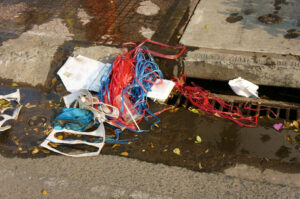 Plastic pollution is one of the biggest issues facing our oceans and marine species. Still today, only a relatively small percentage of plastic is recycled. If a piece of plastic gets kicked down a storm drain in an urban area, and it flows through the watershed, it will eventually end up in the ocean. Most people don’t realize that. People have used the citation that we could very well have more pounds of trash in the ocean by 2050 than fish. Whether this citation is accurate or not, it is illustrative of the problem.
Plastic pollution is one of the biggest issues facing our oceans and marine species. Still today, only a relatively small percentage of plastic is recycled. If a piece of plastic gets kicked down a storm drain in an urban area, and it flows through the watershed, it will eventually end up in the ocean. Most people don’t realize that. People have used the citation that we could very well have more pounds of trash in the ocean by 2050 than fish. Whether this citation is accurate or not, it is illustrative of the problem.
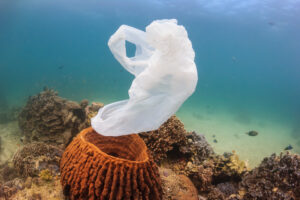 We know that so many of the animals entering animal care and rescue centers at aquariums and other places are coming in because of the intense amount of plastic they’ve consumed. There are so many microplastics floating around and at some point, you reach a point of saturation of consuming too much. There is also the issue of plastic bags floating in the water, which are eaten by many species because they mistake them for jellyfish.
We know that so many of the animals entering animal care and rescue centers at aquariums and other places are coming in because of the intense amount of plastic they’ve consumed. There are so many microplastics floating around and at some point, you reach a point of saturation of consuming too much. There is also the issue of plastic bags floating in the water, which are eaten by many species because they mistake them for jellyfish.
Researchers are beginning to study the impacts of that trash, particularly microplastics, on human and animal health.
What is the best resource for people who want to learn more about this research, or about the issue of plastics in our oceans?
Several organizations are doing great work to address this issue, including 5Gyros, Oceana, and Ocean Conservancy. The National Aquarium is an affiliate of the International Coastal Cleanup, the largest global volunteer effort to clean up shorelines and coastal areas. Data is compiled and published in an annual global report on marine debris by the Ocean Conservancy. It is critically important to clean up and remove plastic that is floating on shore so that it does not go back out into marine environment, but that is a band aid. The real solution is to get alternative packaging for these products in the first place. At the National Aquarium, we have removed all single use plastic from our food service. It is not easy, but it is something that all responsible businesses need to do.

If every citizen of a coastal city took part in a coastal cleanup event, do you think that would help change behavior?
Our cleanup events are done to clean up the coast, but they are absolutely educational. Picking up millions of pieces of Styrofoam, and seeing all the other trash makes a huge impression. Once you do that, you will think twice about how your food is packaged the next time you order takeout.
In what other ways do coastal cities impact animals that live in deeper water?
Another impact coastal cities have on animals in deeper water is related to their contribution to climate change. Rising temperatures are clearly having an impact. There is a substantial body of research related to the impacts of climate change on marine species.

Many marine mammals, such as dolphins, whales, and sea turtles, are migrating north as the water is warming, and they are getting cold-stun effects [when the animal develops hypothermia because it fails to migrate south before water temperatures drop]. Research is showing that a temperature rise of just one or two degrees changes the coral reef environment. Warmer waters can result in coral bleaching, which stresses the coral and makes it more vulnerable. There is also acidification. The ocean serves as a carbon sink; the more carbon the ocean is absorbing, the more the pH balance is changing. That acidification impacts the ability of coral reefs to rebound after a disturbance.
Though our behavior may reflect otherwise, I think most people understand that wastewater, polluted runoff, and trash from coastal cities have a negative impact on life in the water. What are some of the less obvious or lesser-known impacts of the urbanized waterfront on marine and freshwater ecosystems?
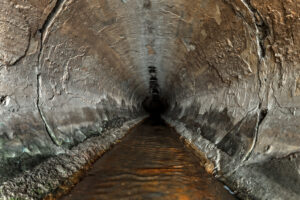
I’m not sure everybody does understand that those things impact life in the water. Most people still do not understand the concept of a watershed or how their day to day activities impact climate change. I also think that most people do not understand that many of our urban coastal areas tend to be some of our oldest cities, because the waterways on which they are located facilitated trade. Many of these cities have very old and outdated infrastructure, including sewer systems. Old and failing sewer systems can lead to untreated sewage entering our waterways. Someone who pours grease down the kitchen sink or flushes wipes down the drain might cause a clog which may negatively impact a sewer system, which could then ultimately result in raw sewage entering our waterways.
How do you address the challenge of getting people in urban communities to understand their place as a watershed and the downstream impact of their behavior, when many neighborhoods may be struggling with issues related to safety, justice, health, and education?
We cannot be approaching people and saying, “Here’s a great conservation solution. Come on board!” At the National Aquarium, and in the conservation community in general, we have changed our approach. We need to approach communities and ask, “What are your issues?” and then discuss how conservation solutions can help address those issues. They can go hand in hand, and there are many examples.
Areas without a sense of place or pride frequently have higher crime rates. Areas that have a lot of litter can create unstructured environments which frequently corresponds with a rise in crime. That is a concern for everyone who lives in that area. That same litter also affects marine and aquatic species. If we can clean up a neighborhood and crime goes down, and the waterways become cleaner, and people have a better understanding of their impact…that is moving in the right direction.
Another example might be a neighborhood where there has been flooding of basements after a severe weather event. Not wanting your basement to flood is a legitimate concern. Perhaps we need to plant and maintain more trees, bioswales, and other green infrastructure that can help prevent basement flooding, while also enhancing habitat and local ecology.
Connecting conservation to other societal concerns-real, true concerns people are facing—and trying to find multiple benefits is very important. We can use nature to solve economic and societal problems, while benefitting nature at the same time.
That same theme resonated through the last issue of Leaf Litter, which focused on urban forestry.
At the National Aquarium, we try to take a triple bottom line approach to our conservation work. When we consider a project, we ask, “What are the economic and social justice components associated with the environmental?” That thinking guides and shapes how we put together a project. We may not always be the most appropriate party to address all of those issues, but in those cases, we try to bring in other collaborators. With the litter issue, for example, we have been exploring the possibility of partnering with the Baltimore City Police Department to help address safety and environmental concerns.
What coastal cities stand out in your mind in initiating policies and actions to protect nearshore habitat?
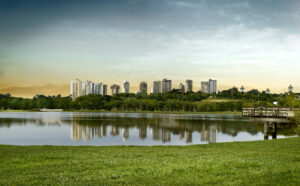
The City of Vancouver decided to move toward renewable energy, and now, they have achieved close to a 90% renewable energy supply. Portland, OR, was one of the first U.S. cities to enact a comprehensive plan to reduce CO2 emissions. Curitiba, Brazil has done a lot of work on public transit and green space.
Curitiba has more green space per inhabitant than any other city in the world, and it was intentional. They did activities such as converting vacant lots to green space for urban agriculture or multi-purpose parks that also provide stormwater management and places for people to congregate. More and more cities are taking positive action such as these.
What about policies you have seen enacted in waterfront cities that have shown promise for improving ecology along the waterfront?
Washington, DC now has a pilot stormwater trading program, which is using the market base to help control stormwater runoff. Many cities, such as San Francisco, CA, are using policies to encourage more green roofs and LEED certifications. The state of California has a plastic bag ban; that was a policy decision directly related to the marine environment. Any city with tree ordinances that are actually enforced is exceedingly positive.
If you had the opportunity to speak at a conference attended by the mayors of every waterfront city in the U.S., what top three actions would you recommend for restoring nearshore habitat and reconnecting people to the water bodies that defined their cities?
First, create green space in your city. Be intentional about it, and plan it as a network that provides ecological and recreational value. There is so much opportunity for this because most cities need to right size. They are either shrinking cities with an abundance of vacant lots, or they expanded very rapidly with many different angles.
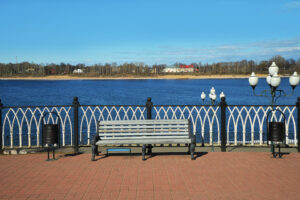
Second, provide access to the water. So many cities are built on rivers that cannot be accessed. In many industrial cities, benches were built facing away from the water. Turn those benches around and provide connection and access points. Facilitate the outdoor industries’ use of the water. When people can access and use the water, they start asking questions about the water. Is it contaminated? Is it safe to swim in? If not, why not? This is all about placemaking, connectedness, and conservation.
Third, enact policies that will benefit the water and withstand changes in administration. Incorporate them into multiple planning and regulatory documents.
You have sat in all seats of the conservation field—NGO, research, regulatory, consultant. Most Leaf Litter readers occupy similar seats. What advice can you offer them when it comes to using their skills and knowledge to restore ecology along urban waterfronts?
Having sat in so many different seats I have learned that it sometimes appears as if priorities are competing when they aren’t. We need to recognize that most of the goals that different parties have are complementary. If we collaborate, we can put policies in place to protect our environment, while also facilitating transportation of goods, economic development, and improvements to social and public health.
The National Aquarium is in the process of transforming its campus in a way that engages people in reconnecting to the water and showcases working ecosystems. What was the impetus behind the Aquarium’s decision to do strive to be a “Model Urban Waterfront”?

The Aquarium is 36 years old. It helped spark the regeneration of the Inner Harbor, and now we’re at the next stage. The on-land attractions of the Inner Harbor are flourishing, but the harbor itself-the actual body of water-is highly contaminated. We said, “We were here to help the first phase of placemaking; now let’s extend it and include the natural environment.”
Last year, you were involved in an effort to have the Baltimore Canyon, an ecologically valuable 28-mile long submarine canyon located 70 miles off Maryland’s coast, designated as the nation’s first urban national marine sanctuary. Why did the National Aquarium want to pursue this designation?
We need to change the paradigm of what it means to be connected to the ocean. There is a misperception that if you are not visiting the ocean or living within a mile of it, you are not connected to it. One of the things were trying to say with the canyon designation is that the ocean impacts all of us. It regulates our climate, provides our oxygen and food, and transports a huge percentage of our goods. We are all connected to the ocean, irrespective of where we live.
The Aquarium ultimately withdrew the application for the designation, and intends to gather more community input before pursuing further. This designation was not only about protecting the canyon, but also connecting people—particularly youth in Baltimore –to the deep sea. What lessons learned from the effort might help other organizations trying to link coastal communities to offshore ecology?

We wanted to connect this canyon back to the urban area of Baltimore with a sense of ownership. The other component of our effort with the canyon has to do with the education of exploration. For youth today, the ocean is the next frontier, the next burgeoning field. It presents a new opportunity to become engaged in researching and protecting it, by learning related new technologies and highly skilled jobs. We want the youth in urban areas to have access to those opportunities. With or without the sanctuary designation, that work needs to continue, as does our work to change the paradigm of what it means to be connected to the ocean. We are really trying to show the relevance of the ocean to a person’s daily life.
Any time we can connect the ocean, water, or environmental issues to other quality of life goals and daily concerns — food, jobs, and transportation– in a way that is engaging, fun, and shows an impact, we are succeeding.
At the National Aquarium, for example, we are about to launch a consumer aquaculture education campaign. Our population is doubling, and as a result our projected protein need is enormous, but 85% of our wild fish stocks are already depleted. Where will we get a sustainable source of protein? It is going to have to be farmed fish. We farm all of our other food. We need to make people realize that a sizeable percentage of what they eat is coming from the ocean. Then they can enter the conservation discussion about the ocean. Those discussions lead into traceability, sustainability, and water quality issues. We’re starting with food because everybody eats!

There are quite a few ecological components to the National Aquarium’s new planned campus. Are there any parts that you’re most excited about?
We’re going to be putting in our new floating wetland prototypes this summer. We have a prototype on the water now and I often see people looking or pointing at it because there is an animal on it. The other day there was a muskrat using it as habitat. I look forward to seeing more people stop and look at the new prototypes. When people stop and look, a connection to the water is starting.
Do you have any final words of advice for Leaf Litter readers?
Our regulatory and environmental agencies simply don’t have the ability to do the amount of monitoring that needs to be done. At the Aquarium, we plan to do more citizen science because we see it as an opportunity to connect people to nature, educate them, and give them skills, while obtaining very necessary data to help benefit the environment. Over the next several years, we intend to create a citizen science hub. We will find ways to engage people in all different aspects of monitoring. I can see citizen scientists helping to track monitoring of wildlife coming back to the waterfront, or helping with water quality monitoring. The educational impact is huge.
We are currently piloting a partnership with Baltimore City Public Schools to initiate a meaningful bay/watershed education program (funded by NOAA) for sixth graders. Over the next couple of years, every 6th grader in the school system will have the opportunity to visit the waterfront and experience activities like water quality monitoring.

Think about it, a lot of these kids live in areas where there are no resources to provide field trips to the Chesapeake Bay or the ocean. Some of these schools use water from storm drains to provide a meaningful watershed experience and for their experiments. Children will be our next leaders. They’re going to be deciding what legislation to vote for and what appropriations and budgets to put forward. Will they put them towards natural resources? That will depend on whether they have that connection as a youth. With more and more children living in urban areas, we have to bring nature back in.

Prior to her tenure at the Conservation Fund, she served as a Senior Program Officer for The National Academy of Sciences, a Department Head for Environmental Resources at the URS Corporation, as the Director of Environmental Programs for the American Association of State Highway Transportation Officials, and as the Legislative Director/Associate Deputy Director for the Association of State and Territorial Solid Waste Management Officials. She began her career working for an environmental television show. Hoellen believes strongly in connecting people to nature and making nature relevant to people to effectuate positive conservation outcomes. She currently serves on the Maryland Climate Change Commission’s Education and Outreach Workgroup, the Transportation Research Board’s Public Lands Committee, and on the Executive Committee of the Aquarium Conservation Partnership. Hoellen holds a Master of Science degree in environmental science and policy from The Johns Hopkins University, and a Bachelor of Arts degree in History from Emory University. We were thrilled to have the chance to chat with her about the impact of urban waterfront communities on life in the water.
To help our readers understand the impact of the urbanized waterfront on marine life—at the shoreline, off shore, or in deep water–could you give us an example of an aquatic organism that is negatively affected by waterfront cities, ideally from the animal’s perspective?

Let’s take the blue crab (Callinectes sapidus) an iconic species here in Maryland. There he is, swimming around in Baltimore’s Inner Harbor. The next thing you know, he’s swimming through stormwater runoff that contains chemicals. Those chemicals change the water quality, perhaps making it more acidic. If that occurs, for species that have shells, this affects the ability for the calcium carbonate within the shells to form and become sturdy. (This also affects oysters and clams, and of course in our coral areas offshore.) That same polluted stormwater through which our blue crab is swimming has brought excess nutrients into the water, which has caused an algal bloom. As that algae decomposes, dissolved oxygen in the water is consumed. So now, our blue crab cannot breathe. He starts coming up toward the surface, and then he runs into trash. The water is toxic for the crab, then he can’t breathe, then he’s hit with trash.
 Plastic pollution is one of the biggest issues facing our oceans and marine species. Still today, only a relatively small percentage of plastic is recycled. If a piece of plastic gets kicked down a storm drain in an urban area, and it flows through the watershed, it will eventually end up in the ocean. Most people don’t realize that. People have used the citation that we could very well have more pounds of trash in the ocean by 2050 than fish. Whether this citation is accurate or not, it is illustrative of the problem.
Plastic pollution is one of the biggest issues facing our oceans and marine species. Still today, only a relatively small percentage of plastic is recycled. If a piece of plastic gets kicked down a storm drain in an urban area, and it flows through the watershed, it will eventually end up in the ocean. Most people don’t realize that. People have used the citation that we could very well have more pounds of trash in the ocean by 2050 than fish. Whether this citation is accurate or not, it is illustrative of the problem.
We know that so many of the animals entering animal care and rescue centers at aquariums and other places are coming in because of the intense amount of plastic they’ve consumed. There are so many microplastics floating around and at some point, you reach a point of saturation of consuming too much. There is also the issue of plastic bags floating in the water, which are eaten by many species because they mistake them for jellyfish.
Researchers are beginning to study the impacts of that trash, particularly microplastics, on human and animal health.
What is the best resource for people who want to learn more about this research, or about the issue of plastics in our oceans?
Several organizations are doing great work to address this issue, including 5Gyros, Oceana, and Ocean Conservancy. The National Aquarium is an affiliate of the International Coastal Cleanup, the largest global volunteer effort to clean up shorelines and coastal areas. Data is compiled and published in an annual global report on marine debris by the Ocean Conservancy. It is critically important to clean up and remove plastic that is floating on shore so that it does not go back out into marine environment, but that is a band aid. The real solution is to get alternative packaging for these products in the first place. At the National Aquarium, we have removed all single use plastic from our food service. It is not easy, but it is something that all responsible businesses need to do.
If every citizen of a coastal city took part in a coastal cleanup event, do you think that would help change behavior?

Our cleanup events are done to clean up the coast, but they are absolutely educational. Picking up millions of pieces of Styrofoam, and seeing all the other trash makes a huge impression. Once you do that, you will think twice about how your food is packaged the next time you order takeout.
In what other ways do coastal cities impact animals that live in deeper water?
Another impact coastal cities have on animals in deeper water is related to their contribution to climate change. Rising temperatures are clearly having an impact. There is a substantial body of research related to the impacts of climate change on marine species.

Many marine mammals, such as dolphins, whales, and sea turtles, are migrating north as the water is warming, and they are getting cold-stun effects [when the animal develops hypothermia because it fails to migrate south before water temperatures drop]. Research is showing that a temperature rise of just one or two degrees changes the coral reef environment. Warmer waters can result in coral bleaching, which stresses the coral and makes it more vulnerable. There is also acidification. The ocean serves as a carbon sink; the more carbon the ocean is absorbing, the more the pH balance is changing. That acidification impacts the ability of coral reefs to rebound after a disturbance.
Though our behavior may reflect otherwise, I think most people understand that wastewater, polluted runoff, and trash from coastal cities have a negative impact on life in the water. What are some of the less obvious or lesser-known impacts of the urbanized waterfront on marine and freshwater ecosystems?

I’m not sure everybody does understand that those things impact life in the water. Most people still do not understand the concept of a watershed or how their day to day activities impact climate change. I also think that most people do not understand that many of our urban coastal areas tend to be some of our oldest cities, because the waterways on which they are located facilitated trade. Many of these cities have very old and outdated infrastructure, including sewer systems. Old and failing sewer systems can lead to untreated sewage entering our waterways. Someone who pours grease down the kitchen sink or flushes wipes down the drain might cause a clog which may negatively impact a sewer system, which could then ultimately result in raw sewage entering our waterways.
How do you address the challenge of getting people in urban communities to understand their place as a watershed and the downstream impact of their behavior, when many neighborhoods may be struggling with issues related to safety, justice, health, and education?
We cannot be approaching people and saying, “Here’s a great conservation solution. Come on board!” At the National Aquarium, and in the conservation community in general, we have changed our approach. We need to approach communities and ask, “What are your issues?” and then discuss how conservation solutions can help address those issues. They can go hand in hand, and there are many examples.
Areas without a sense of place or pride frequently have higher crime rates. Areas that have a lot of litter can create unstructured environments which frequently corresponds with a rise in crime. That is a concern for everyone who lives in that area. That same litter also affects marine and aquatic species. If we can clean up a neighborhood and crime goes down, and the waterways become cleaner, and people have a better understanding of their impact…that is moving in the right direction.
Another example might be a neighborhood where there has been flooding of basements after a severe weather event. Not wanting your basement to flood is a legitimate concern. Perhaps we need to plant and maintain more trees, bioswales, and other green infrastructure that can help prevent basement flooding, while also enhancing habitat and local ecology.
Connecting conservation to other societal concerns-real, true concerns people are facing—and trying to find multiple benefits is very important. We can use nature to solve economic and societal problems, while benefitting nature at the same time.
That same theme resonated through the last issue of Leaf Litter, which focused on urban forestry.
At the National Aquarium, we try to take a triple bottom line approach to our conservation work. When we consider a project, we ask, “What are the economic and social justice components associated with the environmental?” That thinking guides and shapes how we put together a project. We may not always be the most appropriate party to address all of those issues, but in those cases, we try to bring in other collaborators. With the litter issue, for example, we have been exploring the possibility of partnering with the Baltimore City Police Department to help address safety and environmental concerns.
What coastal cities stand out in your mind in initiating policies and actions to protect nearshore habitat?
The City of Vancouver decided to move toward renewable energy, and now, they have achieved close to a 90% renewable energy supply. Portland, OR, was one of the first U.S. cities to enact a comprehensive plan to reduce CO2 emissions. Curitiba, Brazil has done a lot of work on public transit and green space.

Curitiba has more green space per inhabitant than any other city in the world, and it was intentional. They did activities such as converting vacant lots to green space for urban agriculture or multi-purpose parks that also provide stormwater management and places for people to congregate. More and more cities are taking positive action such as these.
What about policies you have seen enacted in waterfront cities that have shown promise for improving ecology along the waterfront?
Washington, DC now has a pilot stormwater trading program, which is using the market base to help control stormwater runoff. Many cities, such as San Francisco, CA, are using policies to encourage more green roofs and LEED certifications. The state of California has a plastic bag ban; that was a policy decision directly related to the marine environment. Any city with tree ordinances that are actually enforced is exceedingly positive.
If you had the opportunity to speak at a conference attended by the mayors of every waterfront city in the U.S., what top three actions would you recommend for restoring nearshore habitat and reconnecting people to the water bodies that defined their cities?
First, create green space in your city. Be intentional about it, and plan it as a network that provides ecological and recreational value. There is so much opportunity for this because most cities need to right size. They are either shrinking cities with an abundance of vacant lots, or they expanded very rapidly with many different angles.
Second, provide access to the water. So many cities are built on rivers that cannot be accessed. In many industrial cities, benches were built facing away from the water. Turn those benches around and provide connection and access points. Facilitate the outdoor industries’ use of the water. When people can access and use the water, they start asking questions about the water. Is it contaminated? Is it safe to swim in? If not, why not? This is all about placemaking, connectedness, and conservation. Third, enact policies that will benefit the water and withstand changes in administration. Incorporate them into multiple planning and regulatory documents.
You have sat in all seats of the conservation field—NGO, research, regulatory, consultant. Most Leaf Litter readers occupy similar seats. What advice can you offer them when it comes to using their skills and knowledge to restore ecology along urban waterfronts?
Having sat in so many different seats I have learned that it sometimes appears as if priorities are competing when they aren’t. We need to recognize that most of the goals that different parties have are complementary. If we collaborate, we can put policies in place to protect our environment, while also facilitating transportation of goods, economic development, and improvements to social and public health.
The National Aquarium is in the process of transforming its campus in a way that engages people in reconnecting to the water and showcases working ecosystems. What was the impetus behind the Aquarium’s decision to do strive to be a “Model Urban Waterfront”?

The Aquarium is 36 years old. It helped spark the regeneration of the Inner Harbor, and now we’re at the next stage. The on-land attractions of the Inner Harbor are flourishing, but the harbor itself-the actual body of water-is highly contaminated. We said, “We were here to help the first phase of placemaking; now let’s extend it and include the natural environment.”
Last year, you were involved in an effort to have the Baltimore Canyon, an ecologically valuable 28-mile long submarine canyon located 70 miles off Maryland’s coast, designated as the nation’s first urban national marine sanctuary. Why did the National Aquarium want to pursue this designation?
We need to change the paradigm of what it means to be connected to the ocean. There is a misperception that if you are not visiting the ocean or living within a mile of it, you are not connected to it. One of the things were trying to say with the canyon designation is that the ocean impacts all of us. It regulates our climate, provides our oxygen and food, and transports a huge percentage of our goods. We are all connected to the ocean, irrespective of where we live.
The Aquarium ultimately withdrew the application for the designation, and intends to gather more community input before pursuing further. This designation was not only about protecting the canyon, but also connecting people—particularly youth in Baltimore –to the deep sea. What lessons learned from the effort might help other organizations trying to link coastal communities to offshore ecology?
Any time we can connect the ocean, water, or environmental issues to other quality of life goals and daily concerns — food, jobs, and transportation– in a way that is engaging, fun, and shows an impact, we are succeeding.
At the National Aquarium, for example, we are about to launch a consumer aquaculture education campaign. Our population is doubling, and as a result our projected protein need is enormous, but 85% of our wild fish stocks are already depleted. Where will we get a sustainable source of protein? It is going to have to be farmed fish. We farm all of our other food. We need to make people realize that a sizeable percentage of what they eat is coming from the ocean. Then they can enter the conservation discussion about the ocean. Those discussions lead into traceability, sustainability, and water quality issues. We’re starting with food because everybody eats!
There are quite a few ecological components to the National Aquarium’s new planned campus. Are there any parts that you’re most excited about?
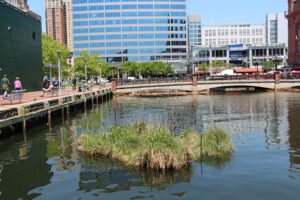
We’re going to be putting in our new floating wetland prototypes this summer. We have a prototype on the water now and I often see people looking or pointing at it because there is an animal on it. The other day there was a muskrat using it as habitat. I look forward to seeing more people stop and look at the new prototypes. When people stop and look, a connection to the water is starting.
Do you have any final words of advice for Leaf Litter readers?
Our regulatory and environmental agencies simply don’t have the ability to do the amount of monitoring that needs to be done. At the Aquarium, we plan to do more citizen science because we see it as an opportunity to connect people to nature, educate them, and give them skills, while obtaining very necessary data to help benefit the environment. Over the next several years, we intend to create a citizen science hub. We will find ways to engage people in all different aspects of monitoring. I can see citizen scientists helping to track monitoring of wildlife coming back to the waterfront, or helping with water quality monitoring. The educational impact is huge.
We are currently piloting a partnership with Baltimore City Public Schools to initiate a meaningful bay/watershed education program (funded by NOAA) for sixth graders. Over the next couple of years, every 6th grader in the school system will have the opportunity to visit the waterfront and experience activities like water quality monitoring.
